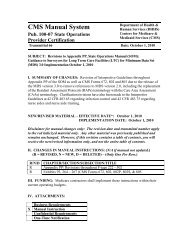2003 Louisiana Vital Statistics Report - Louisiana Department of ...
2003 Louisiana Vital Statistics Report - Louisiana Department of ...
2003 Louisiana Vital Statistics Report - Louisiana Department of ...
Create successful ePaper yourself
Turn your PDF publications into a flip-book with our unique Google optimized e-Paper software.
<strong>2003</strong> LOUISIANA VITAL STATISTICS REPORT TECHNICAL NOTES<br />
CONGENITAL MALFORMATION: a birth defect including a wide range <strong>of</strong> major and minor abnormalities that are noted at the<br />
time <strong>of</strong> birth. They can be the result <strong>of</strong> a wide range <strong>of</strong> factors including genetic disease, teratogens (drugs or other substances<br />
that cause fetal malformation), environmental factors, heredity, and nutrition. However, the causes <strong>of</strong> many birth defects are<br />
unknown.<br />
COVENANT MARRIAGE: a marriage in which the couple agrees to complete premarital counseling from a clergyman <strong>of</strong> a<br />
religious sect or from a marriage counselor. The couple signs a notarized affidavit to the effect that the counselor has discussed<br />
with them the commitment to the marriage for life, the obligation to seek marital counseling if problems arise in the marriage,<br />
and the exclusive grounds for legal separation or divorce. These grounds include: adultery by the other spouse; commission <strong>of</strong><br />
a felony by the other spouse and sentence <strong>of</strong> imprisonment at hard labor or death; abandonment by the other spouse for one<br />
year; physical or sexual abuse <strong>of</strong> a spouse or <strong>of</strong> a child <strong>of</strong> either spouse; living separately for two years; habitual intemperance;<br />
and cruel or severe ill treatment by the other spouse. The waiting period for divorce after legal separation is one year and six<br />
months if there is a minor in the family, and one year in all other cases.<br />
DEATH RATE (CRUDE DEATH RATE): a measure <strong>of</strong> the number <strong>of</strong> deaths in a population during a given period. Death rates<br />
are calculated by dividing the number <strong>of</strong> deaths occurring in a given population during one year by the estimated population,<br />
then multiplying the quotient by 100,000. The rate is expressed as the number <strong>of</strong> deaths per 100,000 population. Crude death<br />
rates are useful for examining actual mortality in a geographic area or population because they describe the rate at which<br />
deaths occur in the total population, without regard to sub-population differences in factors (such as age) that influence death.<br />
Caution must be used when comparing crude rates from different populations, because crude rates can be affected by<br />
differences in the composition <strong>of</strong> the two populations. For example, areas that attract retirees usually have higher crude death<br />
rates than areas with large numbers <strong>of</strong> young families. See AGE-ADJUSTED DEATH RATE.<br />
DIVORCE RATE: a measure <strong>of</strong> divorces occurring in a population during a given period. Divorce rates are calculated by<br />
dividing the number <strong>of</strong> divorces occurring in a given population during one year by the estimated population, then multiplying the<br />
quotient by 1,000. The rate is expressed as the number <strong>of</strong> divorces per 1,000 population.<br />
EARLY ABORTION: an abortion that is performed at or before 8 weeks gestation.<br />
FERTILITY RATE: a rate that relates the total number <strong>of</strong> births (to women <strong>of</strong> all ages) in a population to the number <strong>of</strong> women<br />
most likely to bear children – those aged 15 through 44 years. The fertility rate is calculated by dividing the total number <strong>of</strong> live<br />
births occurring in a given population during one year by the estimated population <strong>of</strong> women aged 15 through 44 years, then<br />
multiplying the quotient by 1,000. The rate is expressed as the number <strong>of</strong> live births per 1,000 women aged 15 through 44<br />
years. Fertility rates are useful for comparisons <strong>of</strong> fertility among age, race, and socioeconomic groups.<br />
FETAL DEATH: death prior to the complete expulsion or extraction from its mother <strong>of</strong> a product <strong>of</strong> human conception that, after<br />
such expulsion or extraction, never breathes or shows any other evidence <strong>of</strong> life. (The term "fetal death" was defined on an allinclusive<br />
basis to end confusion arising from use <strong>of</strong> such terms as stillbirth, abortion, and miscarriage.)<br />
FETAL MORTALITY RATE: a measure <strong>of</strong> fetal deaths occurring in a population during a given period. Fetal mortality rates are<br />
calculated by dividing the number <strong>of</strong> fetal deaths in a given population during a given time period by the number <strong>of</strong> live births<br />
<strong>Louisiana</strong> Office <strong>of</strong> Public Health, State Center for Health <strong>Statistics</strong> Page 165
















